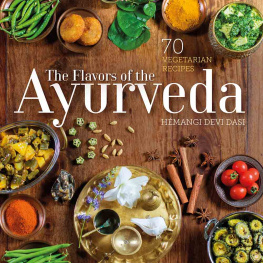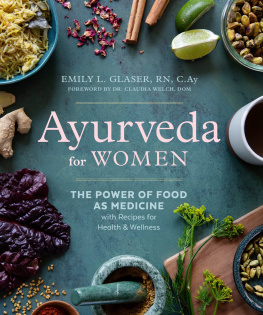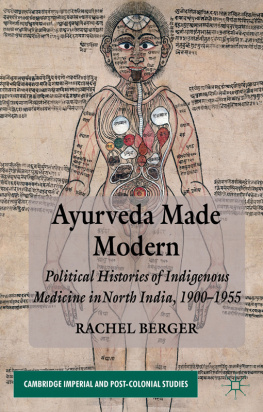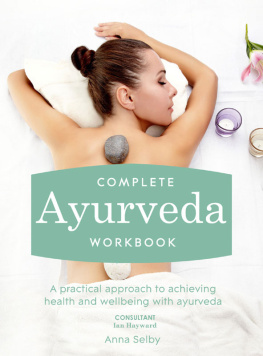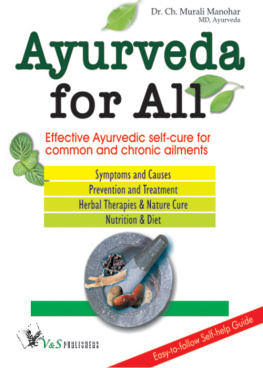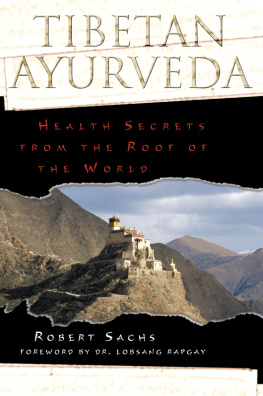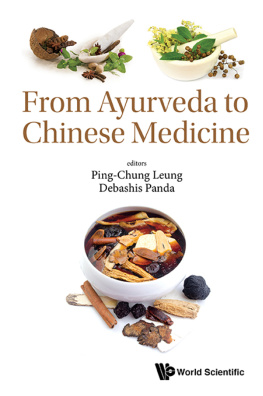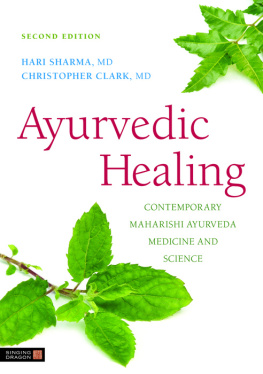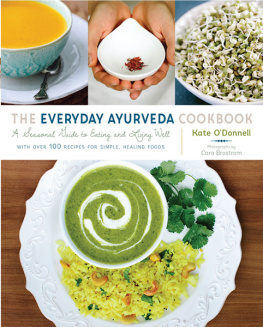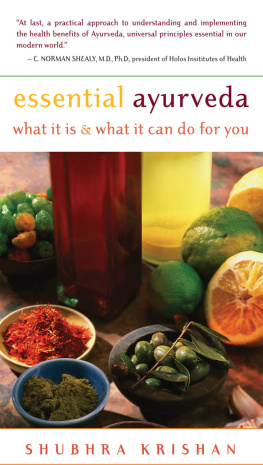Hemangi Devi Dasi
The Flavors of the Ayurveda
70 Vegetarian Recipes
Written by: Hemangi Devi Dasi
Translators:
Rohini Stalker
Gbor Tth
Editor: Braja Sevaki Devi Dasi
Food stylist, professional editor: Viktria Krolyi Bnki
Layout: Sndor Jakab
Photography: Mihly Radvnyi
Lalita Kft., 2018
ISBN 978-615-81125-1-2
Lalita Kft.
H-1137 Budapest, Szent Istvn krt 6.
Tel.: (+3630) 464-7760
108publishing.com
info@108.hu
Publisher in charge: Kozk Mihly
The author, Hemangi Devi Dasi claims to have fallen in love with cooking when she was ten years old. She has been a vegetarian for twenty years. She has lived in the largest eco-village of Central Europe, Krishna Valley in Hungary for many years. Hemangi publishes a food blog (vegavarazs.hu), and teaches cooking courses in Budapest. She has written and published seven cookbooks. The first one, Garden to Kitchen was published seven years ago. It has been re-printed three times, and has been translated to English. Indian cuisine is the closest to Hemangis heart. This book, a sequel to Flavors, Prayers, India, transports its readers to the world of Ayurvedic cousine. Its friendly, chatty tone introduces recipes that are alive, current and easily followed even by people with little experience in cooking. We get to see the person behind the book, a woman who shares her skills and the joy that cooking brings her.
The Publishers
Contents
We pray to Dhanvantari, Vsudeva himself, the Supreme Lord who holds the vessel of the nectar of immortality. Lord Dhanvantari banishes all fear and illness. He is the well-wisher and maintainer of the three worlds. Like Lord Visnu, Dhanvantari heals the infinitesimal souls. We bow to the Lord of the Ayurveda with reverence.
Healing cuisine
Ayurveda is the knowledge that indicates which activities and eating habits are appropriate and inappropriate, auspicious and inauspicious, what brings happiness and sorrow, as well as what increases the measure of life itself
Charaka Samhita 1.41
This ancient knowledge, in all of its flavors, is a gift to todays man. Ayurveda places the individual in the center: it focuses on our specific body type, individual characteristics, in other words, us. Keeping in mind our uniqness and the varied causes of a presons ailments, it recommends an individually tailored course of healing. In the system of Ayurveda, the saying what is medicine for one person is poison for another gains real meaning.
Instead of focusing on the state of illness, an Ayurvedic doctor bases his recommendations on the original, healthy state of the individual. He prescribes a diet and medicine to re-create harmony that replaces the diseased state, or, better yet, preserves our health.
Western diets and current lifestyle advice is ridden with controversies: is milk healthy? are potatoes, grains, eggplants? Before answering these questions, Ayurveda looks at the individual. It considers the physical and subtle characteristics of the patient.
According to Ayurveda, there are three elements to preserving our health: proper diet (ahara), a healthy lifestyle (vihara) and the utilization of herbs (ausadhi). This book discusses the first element, diet. It offers palate pleasing medicine in the form of tasty recipes so people may to utilize this ancient knowledge in their kitchens to preserve or restore their health, and the health of their loved ones. It is more than just a collection of recipes; it teaches the practical application of Ayurveda to help us find out what our Ayurvedic constitution is, and what diet, what food helps us achieve the harmony of the body and mind that guarantees lasting health.
With the help of Ayurveda, we will not only learn how to fend off disease, we will also be able to understand our disposition, and what makes our family members and fellow humans act the way they do. We can find out what diseases we will be prone to, and what the best way to heal those diseases is.
We will learn what to eat during the summer to feel comfortable, and why gingerbread is the perfect snack in the winter. With the right food we can finally get rid of our childs recurring sinus infection and help our husbands overcome insomnia. Dinner could be the elixir that heals us!
Dear reader! I hope you get to know this miracle. May cooking become a meditation, an adventure, an exciting journey, filled with flavors, toward an energetic life and a peaceful mind.
Hemangi Devi Dasi
The Roots of Ayurveda
Ayurveda, the science of life (ayus life, veda knowledge, science), originated thousands of years ago.
The Vedic literature is a storehouse of knowledge. The ancient Vedic writings consist of fourteen texts, such as the four Vedas (Rig, Rajur, Sama, Atharva), the six Vedangas (supplementery texts), the Mimamsas (purports), Jnana (logic), Puranas (philosophy) and the Sastras (codes of ethics). Just as there are Vedic mathematics, astrology and arhitechture, medicine is also part of the Vedas.
The scholars of the Ayurveda compiled the parts of the Vedas that pertained to medicine. It is thanks to these compilations (Samhitas) that this knowledge survived the test of time.
The Charaka-Samhita establishes the basic concepts and discusses illnesses and the use of herbs. This text is still the main textbook for doctors and therapists practicing Ayurveda. It is estimated that it was written between 1000 and 500 b.c.
The Sushruta-Samhita discusses anatomy and surgery. It describes complicated surgical procedures for its time, such as plastic surgery, amputation, and skin grafting. It utilized plant based sedatives that had anti-biotic properties and helped healing as well.
Ayurveda is referred to as the mother of medicine, since the origins of modern healing systems can be traced back to this ancient knowledge.
The eight brances of Ayurveda
- Kaya-chikiekza internal medicine
- Salakya-tantra ears, nose and throat, eyes
- Salja-tantra surgery
- Agada-tantra toxicology
- Bhuta-vidja psychiatry
- Kumara-bhritja gynecology, birthing and pediatrics
- Rasajana rejuvenation and restoring youthfullness
- Vaji-karana the science of reproduction
These were advanced sciences. Toxicology discussed led-, mercury-, and arsenic poisoning along with the toxins that are produced by plants and animals. Ayurvedic pediatrics and gynacology discusses an individuals lifes progression from the time of conception to puberty. It places great emphasis on the health of the embryo within the womb, and recommends a specific diet during pregnancy.
Ayurveda stresses the prevention of illness, teaches how to take care of the ill, and discusses ethics and the proper character of a good doctor.
The Essence of Ayurveda
The main difference between Western medicine and Ayurveda lies in Ayurvedas holistic nature. Rather than treating symptoms, it searches for the root of the problem in the consciousness, senses, and existence. It offers a very detailed guidance on lifestyle, including diet, daily duties, work, rest and recreation, and sleep. Its basic tenement is that one cannot heal the body alone while disregarding the mind.
According to Ayurvedic medicine, there are three elements to preserving health:
- proper diet (ahara);
- a healthy lifestyle (vihara);
- using herbs (ausadhi).
Doshas
According to Ayurveda, everything around us is made up of five elements: ether (akasa), air (vaju), water (jala), fire (agni), and earth (prithvi). As long as these five elements are in balance, the universe works in harmony. Where the balance tips over, natural cathastrophies floods, earthquakes, extreme tempertures occur. The same is true of the human body: we are healthy as long as the elements of our bodies are in balance.

